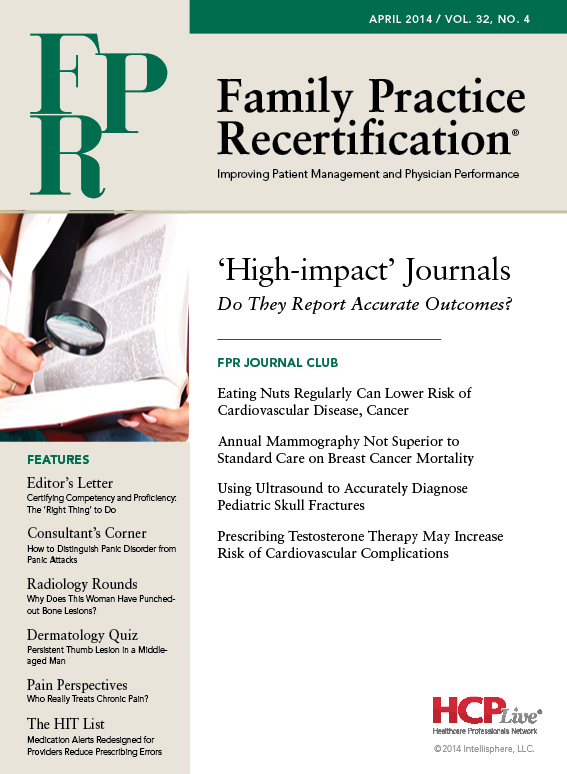Publication
Article
Family Practice Recertification
Using Ultrasound to Accurately Diagnose Pediatric Skull Fractures
Author(s):
Ultrasound can lessen the need for head scans in children and reduce the impact of radiation on the developing brains of those who are particularly sensitive to ionizing radiation.
Review
Rabiner JE, Friedman LM, Khine H, Avner JR, Tsung JW. Accuracy of point-of-care ultrasound for diagnosis of skull fractures in children. Pediatrics. 2013;131(6):e1757-64. http://pediatrics.aappublications.org/content/131/6/e1757.abstract.
Study Methods
This was a prospective observational study of 69 pediatric patients with head injuries and/or suspected skull fracture to determine the diagnostic accuracy of point-of-care ultrasound compared to computed tomography (CT) scans. The study was performed at the pediatric emergency departments (EDs) of 2 urban, level II trauma centers from September 2010 to March 2012.
Prior to their ultrasounds, the patients were assessed based on clinical characteristics that included scalp hematoma and location, loss of consciousness, vomiting, altered mental status or Glasgow Coma Scale (GCS) score <15, and/or palpable skull fracture. All patients were ≤21 years of age and presented with head trauma and/or suspected skull fracture, which required radiologic evaluation with head CT scans as determined by the enrolling pediatric emergency medicine (PEM) physician. The study excluded subjects with completed radiologic studies, confirmed skull fracture, or open fracture, as well as those who required urgent intervention.
Before performing the ultrasounds, certified PEM physicians received a 1-hour didactic and hands-on tutorial on proper ultrasound technique and evaluation. A positive skull ultrasound was defined as any cortical disruption or visualized irregularity.
Following the ultrasound, all patients underwent head CT scans, which are considered the gold standard for diagnosing skull fractures. The ultrasound results were compared to the results of head CT scans, with the radiologists remaining blinded toward the ultrasound interpretations. One week after the ED visit, a single phone call was placed to patients without a definitive skull fracture on CT scan to determine their clinical outcome.
Results and Outcomes
With a confidence interval of 95%, PEM physicians were able to diagnose skull fractures via point-of-care ultrasound with a sensitivity of 88% and a specificity of 97%. Additionally, inter-observer agreement of ultrasound interpretation among the PEM physicians was found to be very high, indicating close agreement among the observers. The likelihood ratio of a positive test was 26.7 and the likelihood ratio of a negative test was 0.13, meaning there was a strong correlation between a positive test result on ultrasound and high likelihood of a true skull fracture.
Three discordant results between ultrasound and radiologic findings resulted in 2 false positives and 1 false negative. The first false positive resulted from an error in interpretation by the PEM physician, though it was correctly interpreted as negative by the expert ultrasonographer. The second false positive was due to a minimally displaced skull fracture, which was also confirmed by the expert ultrasonolographer, though it was undetectable by CT scan. The single false negative resulted from a nondepressed skull fracture adjacent to the area of the patient’s scalp hematoma that was not visualized on the ultrasound.
In combination with previous studies that measured the diagnostic accuracy of ultrasound in skull fractures, the authors calculated a sensitivity of 94%, a specificity of 96%, a likelihood ratio of a positive test of 25.4, and a likelihood ratio of a negative test of 0.06 among 185 pediatric patients.
Conclusion
The results strongly supported the accuracy of ultrasound in diagnosing skull fractures among pediatric patients following a 1-hour training session for PEM physicians.
Commentary
This study established the diagnostic accuracy of ultrasound in skull fractures among pediatric patients. Although ultrasound may prove to be useful as an accurate, cost-effective, and efficient tool, there remains the issue of whether the modality would decrease the overall use of CT scans, due to the need to evaluate patients for intracranial hemorrhage. Therefore, future studies must establish the larger impact of ultrasound on the overall management of skull fractures. Additionally, as ultrasound becomes more widely employed, standardization of training must be implemented in order to ensure proper utilization of this modality.
Ultimately, ultrasound would lessen the need for head CT scans in children and reduce the impact of radiation on the developing brains of those who are particularly sensitive to ionizing radiation. The modality would also help diagnose skull fractures faster and obviate the necessity for sedation in young children.
There are many different settings where point-of-care ultrasound could be vital. The most obvious ones are those that lack access to CT scans, including the developing world, urgent care centers, primary care offices, and mass casualty disasters.
Nonetheless, it would be difficult to incorporate the technique in places that lack trained providers, since training was limited to PEM physicians in this study. Thus, future research should attempt to determine whether any ED physician who receives the training is qualified to utilize ultrasound in skull fractures.
This study further supported the expanded role of ultrasound in emergency medical care. In appropriate circumstances, it is a win-win combination of low cost and low risk.
About the Authors
Daniel Choi, MS IV, is a fourth-year medical student at the University of Massachusetts Medical School (UMMS) in Worcester, MA.
He was assisted in writing this article by Frank J. Domino, MD, Professor and Pre-Doctoral Education Director for the Department of Family Medicine and Community Health at UMMS and Editor-in-Chief of the 5-Minute Clinical Consult series (Lippincott Williams & Wilkins).






